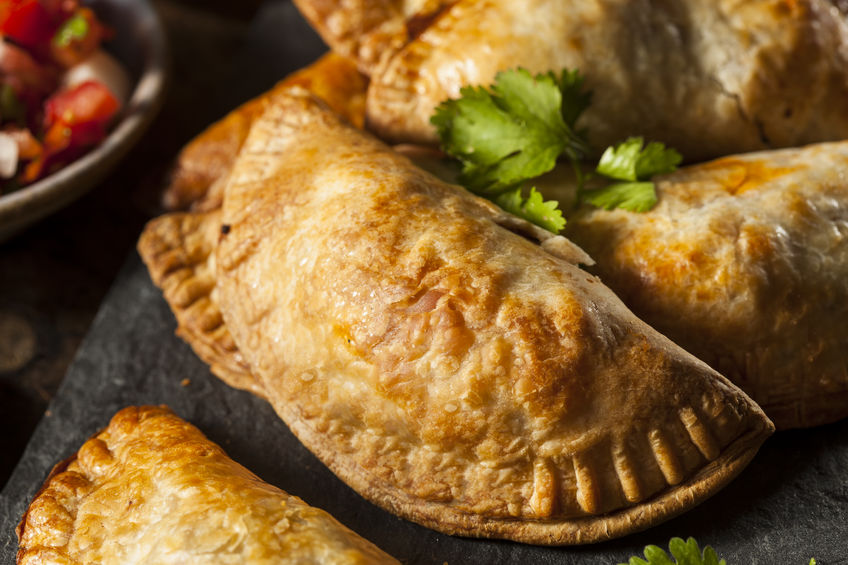America is absolutely bursting at the seams with food — in more ways than one. Yes, America is fat, but it’s so much more than just fat! It’s actually a really great melting pot (pun intended) of global cuisines. While even the most adventurous foodies living in a big metropolis like New York City can feel like they’ve had everything, there are some stomach-stuffers that are rarer than a quick-cooked steak. Here are four kinds of foods from around the world you definitely need to try before you reach the point in your life where the majority of your food gets injected into your body via tube.
Australian
Despite the many similarities to American cuisine – Aussies love to eat meat, cook barbecue on a sunny summer’s day, and indulge their sweet teeth in all things fattening and gluttonous – Australian food can throw some unexpected curve balls. The occasional Aussie-themed café pops up in New York, but you really don’t need them to attempt cooking Lamingtons. This simple tea cake covered in melted chocolate and coconut is a dessert you can’t turn away.
When it comes to Australia’s other national cuisine, some people might think that it’s strange that Australians eat cute and cuddly kangaroos, but that’s okay, because they’re delicious. The kangaroos, I mean, not those small-minded weirdos. Easily prepared with a marinade of olive oil, rosemary, and garlic, kangaroo is an especially tasty red meat alternative for any number of recipes including burgers, stir frys, sausages, meatballs, and is growing in popularity as a variety of jerky. It’s slowly finding a place in American restaurants and certainly butchers should know where you can get it if you want to experiment with its sinewy goodness.
British
It’s hard to find a restaurant in America that doesn’t have fish and chips on the menu, but for whatever reason the traditional British kind of fish and chips got lost in translation. While there are a few places like A Salt & Battery in New York’s Greenwick Village that attempts to recreate the tasty, oily goodness for foreigners in desperate need of a craving fix, you should know that it’s pretty hard to recreate in your own home (and which is why specialty restaurants can charge an arm and a leg for what normally doesn’t cost more than a tenner back home).
What is easily to replicate is Yorkshire Pudding, a delicious cooked batter made from simply eggs, flour and milk and which goes superbly with a roast – perfect to sop up gravy. Whip up a batch and pour it into a cooking pan with a few gourmet sausages and cook for 30 minutes to create your own Toad in the Hole. It may not sound glamorous, but it’s incredibly tasty and a hearty winter dish.
Macanese
Macau isn’t just that exotic place where James Bond went gambling in Skyfall. It’s a place with vibrant cuisine that marries some of the best parts of its Portuguese, Chinese, and Southeast Asian ancestries. Its history as a trading port means it is possible to find touches of Latin, Brazilian, African and Indian cuisine amongst Macanese cooking, and the Spanish tradition of tapas is a popular Macau cuisine staple.
Macau’s version of a hamburger, the Pork Chop Bun, is so simple that it’s surprising the nation’s most popular street food hasn’t caught on with food trucks over here. It is literally just a pork chop in a bun! It helps that the warm, usually slightly-spiced buns need to be very crispy on the outside and extremely soft and fluffy on the inside — think the bread version of a crème brulee with that fantastic crack on the surface — to make it special and texturally intricate on the palate. If you’re in Macau, they are sold everywhere. Elsewhere, pig ear and papaya salad is a creative side-dish waiting to be adopted, and the famed Portuguese custard tarts for which Macau is well-known incorporate traditional spices for a more authentic taste than those boring old generic egg tarts found in other parts of the world.
Bolivian
Peruvian food has found a surge in popularity in recent years as foodies discover there’s more to South American cuisine than meets the eye. Bolivian cuisine, however, hasn’t found its cultural emergence yet. The country is home to an abundance of corn agriculture and over 1200 varieties of potato, making them staples country-wide. Bolivia is also one of the world’s biggest producers of quinoa, meaning it is easy to give a meal a Bolivian twist without even realizing it.
Most people have tried empanadas, so the local dish known as salteñas won’t be foreign to you, but these are stickier and juicier and soupier. There are many varieties of them throughout the country that are served at different times of the day, so you can always find the perfect one for the moment the next time you want to cook this regional food. Likewise, humintas are a Bolivian twist on tamales that are made entirely from ground corn and are sweeter, and can include sugar, cinnamon, and raisins in the mix. A humintas recipe can be modified quite easily to be made as a form of cake just like cornbread, but with a slight hint of chili to give the sweetness a kick, and works really well alongside an avocado and quinoa salad.














-300x200.jpeg)
-300x213.jpeg)










